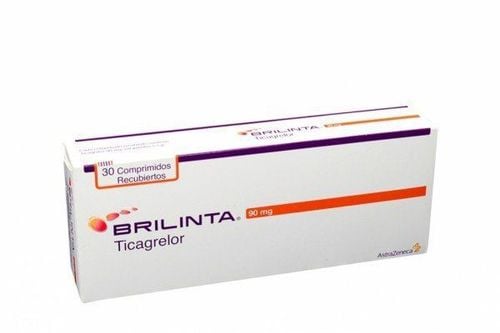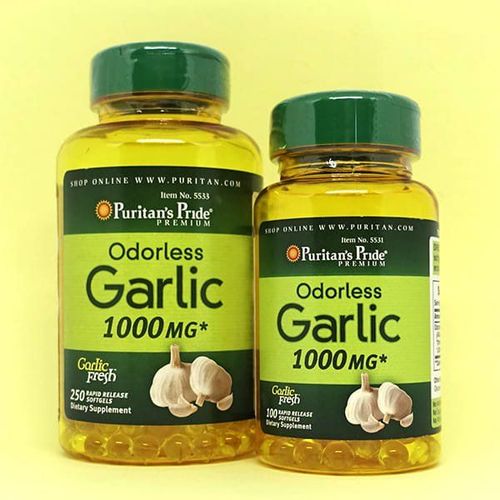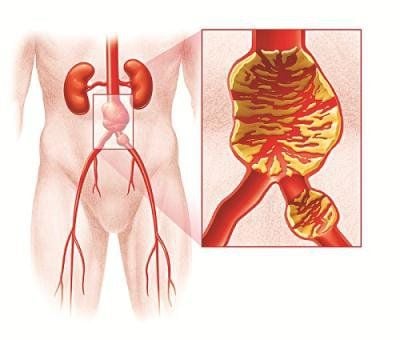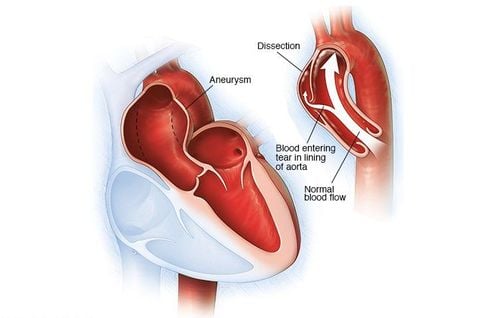This is an automatically translated article.
The article is professionally consulted by Cardiologist - Department of Examination & Internal Medicine - Vinmec Phu Quoc International General Hospital
Aortic aneurysm is one of the most common diseases and accounts for a high mortality rate in Vietnam. Aortic aneurysms often have no obvious signs and are common in people 60 years of age and older.
1. What is an aortic aneurysm?
The aorta is the most important part of the artery, responsible for carrying blood from the heart to the whole body. The aorta consists of: the thoracic aorta and the abdominal aorta. The size of the aorta is about 2 - 3.5 cm and usually increases with age. The aortic wall consists of 3 layers: the inner layer, the middle layer, and the outer layer.Aortic aneurysm is a condition in which the aorta is larger than normal, increasing in size in the shape of a sac or rhombus. When the diameter increases to 50% of normal, it is considered an aortic aneurysm.
Abdominal aortic aneurysm. (AAA) This is the most common area of aortic aneurysms (about 75%). Abdominal aortic aneurysms develop in the lower part of the aorta. Usually asymptomatic or very vague until just before the rupture of the artery. Symptoms are usually:
Pain in the middle and lower back Abdominal discomfort Feeling like a pulse is beating in the abdomen
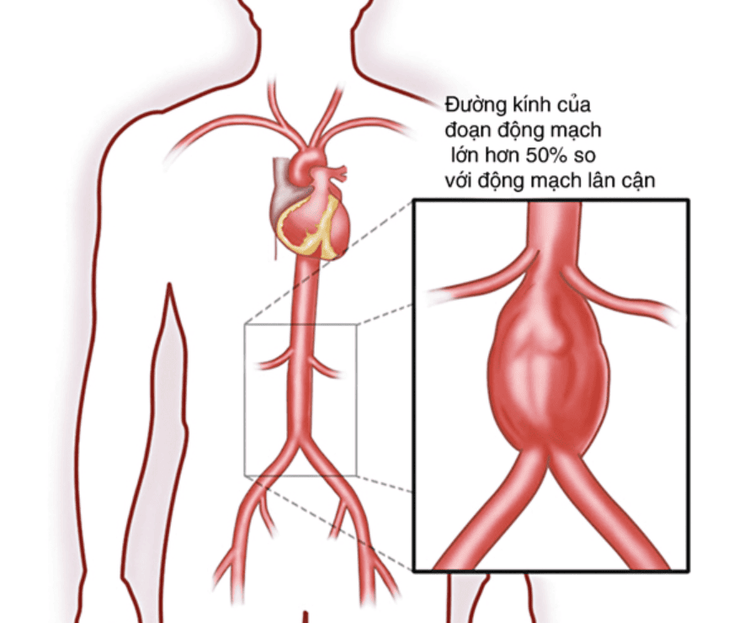
Phình động mạch chủ là hiện tượng động mạch chủ bị phình to ra hơn so với bình thường,
Pain in the chest and back Difficulty breathing Rapid heart rate Aneurysms in the aortic arch are a rare site and difficult to treat Aortic aneurysm rupture Aortic aneurysms are very dangerous, in 80% of cases, rupture behind the left peritoneum and can partially limit rupture. The remaining cases ruptured in the peritoneal cavity and caused uncontrolled bleeding leading to rapid cardiovascular collapse. Aneurysm rupture causes thoracic bleeding leading to death. The larger the aneurysm, the higher the risk.
When an aortic aneurysm ruptures, symptoms occur very quickly such as:
Dizziness, blurred vision Difficulty breathing Pain in the chest, abdomen and back Decreased physical strength and loss of consciousness
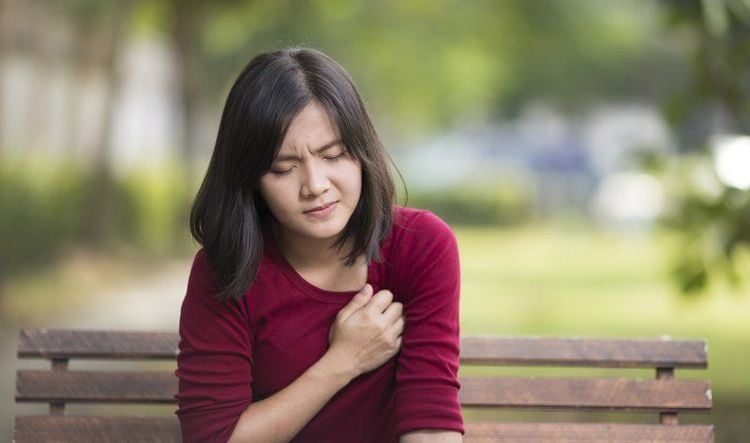
Phình động mạch chủ ngực gây khó thở
2. Effects of aortic aneurysm on other organs
Aortic aneurysms form blood clots. When moving, these blood clots will damage the internal organs they pass through, causing the appearance of a number of other quite dangerous diseases such as: stroke, kidney failure, heart attack,...Symptoms : Chest pain, decreased vision, hematuria,...
2.1 Causes of aortic aneurysm to other organs Aging : The aorta enlarges and weakens over time, most people with aneurysms The motherboards are all in their 60s or older. Smoking: As one of the direct causes of disease. Therefore, the incidence of aortic aneurysm is higher in men than in women. Untreated high blood pressure also causes aneurysms. Family members with a history of the disease without connective tissue disease. Atherosclerosis: Atherosclerotic plaque adheres to the walls of blood vessels, making the vessel walls stiffer over time, making the vessel walls weaker and increasing the risk of aneurysms. Marfan syndrome: An inherited disorder affecting connective tissue that can cause complications in several organs including blood vessels. Ehlers-Danlos, Loeys-Dietz are rare disorders that also affect the connective and supporting tissues of blood vessels as well as in bones, skin, and certain organs and tissues. Loeys-Dietz can also dilate the aorta. Vasculitis can cause thoracic aortic aneurysms such as: Arteritis, Takayasu disease.. Abnormalities in the aortic valve that increase blood vessel wall pressure also increase the risk of disease. One of the rare causes of aortic aneurysm is untreated infection, chest trauma, polycystic kidney disease, high cholesterol, etc.
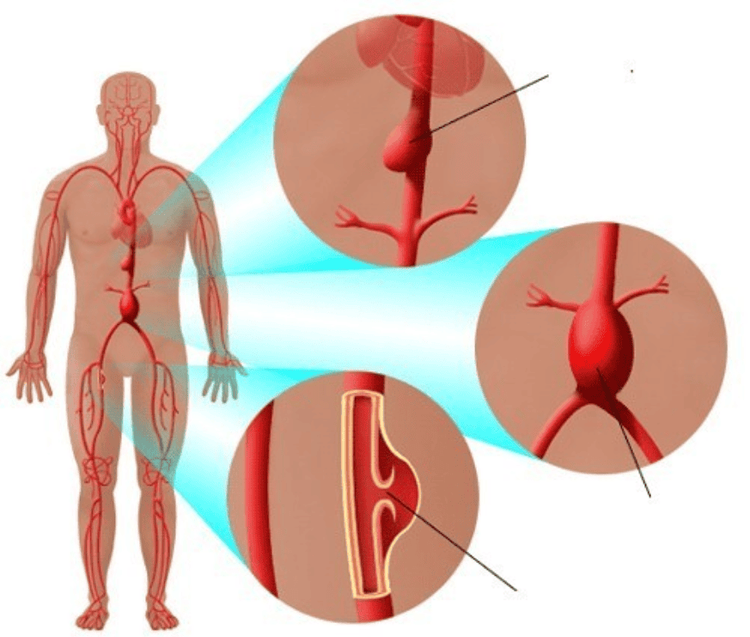
Nguyên nhân hiếm gặp làm phình động mạch chủ là do nhiễm trùng không được điều trị
Prevent arterial rupture Monitoring over time If the aneurysm grows too quickly, surgery will be considered. There are 2 types of surgery:
Open surgery: Replace the damaged aorta with a PTFE graft. This method is quite dangerous and painful. Endovascular surgery. Stent graft treatment is a modern method that shortens the treatment time as well as brings efficiency in the treatment process.
2.3 How to prevent aortic aneurysms from spreading to other organs Some methods help to prevent and significantly reduce the risk of aortic aneurysms :
Don't smoke Proper diet: Reduce sugar, fat fat, salt; Eat a lot of vegetables, fruits, ... Periodic check to ensure blood pressure is always in stable condition Control cholesterol level to reduce the possibility of atherosclerosis Avoid stress, work in moderation, have a happy lifestyle looks, healthy Exercise, lose weight.

Không hút thuốc giúp phòng tránh phình động mạch chủ
Vinmec International General Hospital is the leading medical address for diagnosis and treatment of aortic aneurysms. It has all the necessary medical equipment to perform simple to complex treatments such as medical treatment, stent-graft intervention,... Professional medical team are highly qualified, have undergone training and are granted technical certificates, can handle quickly and effectively, especially in cases of urgent emergency. Therefore, patients with thoracic aortic aneurysms can rest assured with a strict, methodical and effective treatment process at Vinmec.
Master. Doctor Danh Man graduated with a Master of Medicine from the University of Medicine and Pharmacy in Ho Chi Minh City. Ho Chi Minh City and has many years of experience in the examination, prevention and treatment of cardiovascular diseases. Currently, the doctor is working at the Department of Medical Examination & Internal Medicine - Vinmec Phu Quoc International General Hospital.
Please dial HOTLINE for more information or register for an appointment HERE. Download MyVinmec app to make appointments faster and to manage your bookings easily.





